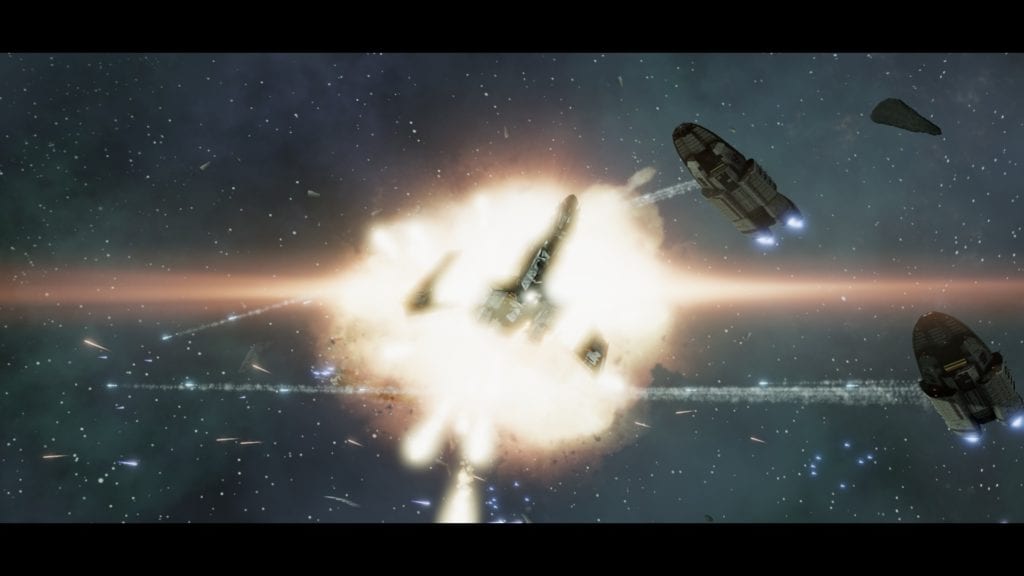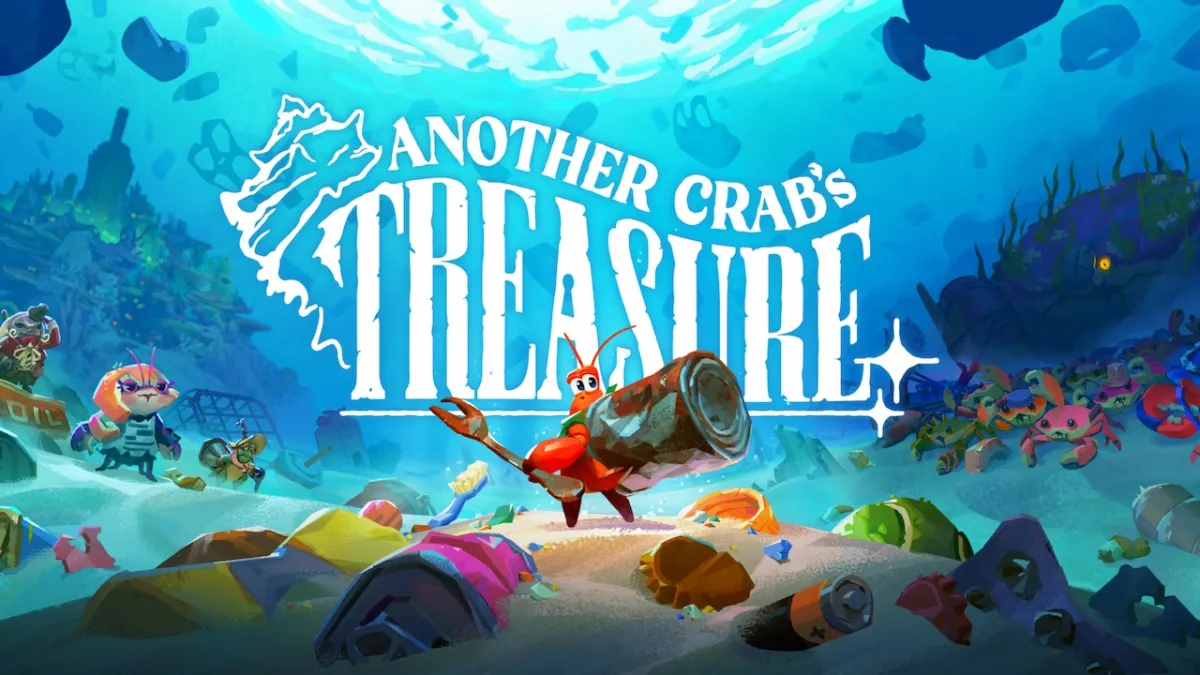Battlestar Galactica’s 2004 revival and its various spin-offs disappeared from our screens a few years ago, but it’s a series that retains a strong following. Despite this level of name-recognition and a setting almost tailor-made for the medium it hasn’t had much success in the world of videogames. Until now that is, when the license has been astutely dusted off by Slitherine and Black Lab Games for Battlestar Galactica: Deadlock; a title dominated by tactical fleet combat.
Based around the 2004 version of the series, Deadlock is set during the events of the First Cylon War. As prequels go, that puts it a long time before any of the events involving Adama and company. However, a couple of familiar surnames do crop up throughout, and the campaign story-line takes a brief pass at some of the more overt themes: uneasy Colonial alliances, authoritarian military decisions in times of crisis, and the ontological status of the Cylons in relation to humanity.
The narrative is pretty sparse (and while I did watch the show I’m not a die-hard, so I don’t know if this plot retcons anything), but it does a reasonable, if slightly confusing, job sketching out a version of events for the war. It’s with aesthetics, though, that Battlestar Galactica: Deadlock does the series much more justice.
The ship roster on both Colonial and Cylon sides has been expanded in order to depict earlier designs and provide a decent line-up for each. Alongside Jupiter-Class Battlestars and Cylon Base Stars you’ll find vessels like the pragmatic Adamant Frigate and the Raider-filled Cerberus Carrier. These creations fill their respective tactical roles, but also look and (mostly) sound the part.
Audio in Battlestar Galactica: Deadlock is handled very well. DRADIS pings sound straight from the show, and, while the studio didn’t get Bear McCreary, Ash Gibson Greig’s score does a fine job channelling a similar tone of space-mysticism. Combat effects are a bit more mixed (engines and missiles are generally good, Viper attack runs sound rather weak), and the voice acting ranges from decent to somewhat flat. You can’t skip any of the dialogue sequences, sadly.
The fact that it treats the license with care should automatically win the game a certain amount of affection. Those looking for a squadron-based fleet tactics game with a lighter dynamic campaign overview will find things to like too. After a few linear tutorial missions, Deadlock opens its galactic star-lanes up with a few elements reminiscent of XCOM. Cylon threats will harass the Colonies, resources run thin as planets consider defection, and named fleet commanders can be upgraded with straightforward skill trees.
The strategic campaign mechanics have a bit of an ‘old school’ feel to them, which I don’t mean as a pejorative, but which I do mean to imply are initially unforgiving. Aspects like how dedicated you should be to putting out the fires of Cylon raiding fleets, and what amount of ship losses can be deemed ‘acceptable’ without tanking your long-term prospects are left rather obtuse. A few display choices, like the method to check on Cylon fleet strength (not by clicking on them, or hovering over, but in a dedicated tab in the bottom-left) are poor decisions.
Only the semi-random Cylon fleets have their strength displayed at all, so whenever you approach a side or main mission you’re going in blind. Main missions escalate in a pretty identifiable pattern, but the side stuff (a useful way to acquire more resources) remains haphazard. You won’t know until you’re there whether you’re facing a handful of corvettes or the brute force of a Cylon vanguard (except for the missions that explicitly state it’s a Cylon strike team in their text). Retaining some suspense about enemy forces is fine, but the more egregious moments are likely to just get players re-loading a save.
But even though it’s somewhat flawed, the campaign layer of Battlestar Galactica: Deadlock does succeed in getting you to think carefully about allocating sparse resources to ship construction, research, and even to travel (spooling up your drives every single turn gets costly). That said, I think most will resort to creating powerful second or third fleets and auto-resolving the steady stream of Cylon raid encounters, as the alternative is awfully repetitive. I’m also unsure if you can ever truly ‘lose’ from too many Colony departures, as that never happened during my campaign.
The tactical heart of the game is in the more crafted fleet encounters. In-game logistical limits mean that battles are restricted to seven (on your side) versus seven-but-sometimes-more on the part of the Cylons, but that often turns out to be plenty to consider when ordnance and fighters are included. I’m also not sure the present UI could handle the density of more ships.
Battlestar Galactica: Deadlock uses a turn-based system dubbed ‘WEGO’, in which orders are input for both forces and then the turn plays out in real time. That means you need to keep in mind where the enemy ship will be when you bring your firing arc (hopefully) to bear upon it. Same goes for the movement trajectory of all nearby vessels, because you don’t want to end up with a collision. Unless, of course, it’s a last-ditch suicide maneuver. Space in Deadlock is 3D, so there is a Z Axis in play with any movement decisions as well.
The AI doesn’t have any particularly incredible tactics, relying instead on numbers and (in missions) scripted surprises, but it does stick well to its roles. Smaller Nemesis ships will use their hacking abilities to cripple your fleet’s systems, Gunboat-type vessels will close in for broadsides, missile barges will generally stay back and launch salvos, and so on. It’s up to you to figure out the best counters to these combined-arms assaults. Often, that’s the ever-reliable Adamant Frigate, which can equip both ordnance (armour-piercing, anti-missile, even a nuke once they’re researched) and fighters.
The latter are incredibly useful. A few Viper squadrons can obliterate a much larger ship with a hole or two already punched through its armour. They’re quite handy in defense too, able to shoot down approaching missiles.
A further layer is added by the ‘ship posture’ mechanic, allowing you to tweak how much of an attacking or defensive stance the vessel will have that turn. You can ramp up the defense to stave off a hacking attempt a little longer, or go for maximum levels of firepower just as you lure a ship into several firing arcs at once. The UI for applying all of these things is adequate, but also fairly basic in presentation and large enough to obscure parts of what can become quite cluttered space battlefields.
Satisfaction in the 14 mission (12-15 hour, on Normal difficulty) single player campaign comes from overcoming the odds in combat and leading your stretched forces to victory. Lack of resources (and the fleet cap) means you’ll always be up against it in the story missions, but deft use of the tools available will always give you the advantage over a capable, but somewhat predictable AI.
It’s then possible to revel in these victories even further with the post-mission replay function. I don’t normally make great use of these systems (a one-off spectacular goal in FIFA or something unique like SUPERHOT, perhaps), but the one in Battlestar Galactica: Deadlock is rather brilliant. It replicates the in-fight camera style from the show (a lot of pan-and-zoom, and Viper nose-cam) to retell the story of the battle. Several missions in, I was still dipping in to these to watch a bit of glorious tactical acumen played out in cinematic style.
But while the post-battle replays are great, a major incentive to replay the actual campaign is presently a bit lacking. Upping the difficulty to its hardest setting (and struggling with even fewer resources) is really the one and only option, because once you’ve played the main missions you can’t ‘unlearn’ the times when additional Cylons show up. That initial mad scramble to adjust to new threats won’t really happen a second time.
To find new challenges in Battlestar Galactica: Deadlock you need to turn to Skirmishes (which can be both single and multiplayer). Offline, you can test yourself against Cylon forces as either Colonial or Cylon forces in mid-sized or large matches between pre-created or customised fleets. I can only presume you can’t fight against Colonial AI because it doesn’t yet exist.
Multiplayer offers both one vs one combat and two player co-op against the AI, the latter of which is an unexpected but welcome inclusion. All the tactical options from the single player campaign are available here, as are the same point-based and numerical fleet caps.
Battlestar Galactica: Deadlock earns itself a lot of goodwill for the attention it pays to an unloved (in the world of games, at least) license. That care extends furthest to the tactical combat, which in many ways is a logical extension of Black Lab’s previous Starhammer title. Fleet limitations mean the conflicts are more squad-sized, but this does result in each ship being more of an individual unit than an expendable war resource; plus it avoids the awkwardness of even more UI clutter. The combined-arms approach of firing arcs, missile types, and fighter roles works well, and means each mission can present a compelling set of challenges with various solutions.
The strategic campaign layer is the weaker of the two distinct parts. Having the threat of Colonial defections affecting your resources is a solid retread from XCOM, but the Cylon raids are too haphazard and end up more like irritations than a genuine, constant danger. But it does possess a certain old school, obtuse challenge that I appreciate, and commits to making you allocate slender supplies. While Battlestar Galactica: Deadlock has its share of minor problems, they don’t significantly detract from some engaging tactical encounters within a universe of familiar sights, sounds, and Cylons.










